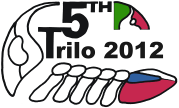Joseph H. Collette
| Name: | Mr. Joseph H. Collette |
| Country: | United States |
| Institution: | University of California - Riverside |
| Address: | Joseph Collette University of California - Riverside Geology Building 900 University Ave. Riverside, CA 92521 |
| E-mail: | jcollette003 (at) gmail (dot) com |
Contributions
A bridge too far? Late Cambrian Laurentia – Gondwanan “saukiid” trilobite distribution, evolution, and dispersal
Joseph H. Collette, Nigel C. HughesSection: Evolution and systematics, Presentation: Oral
Saukiidae, saukiid, systematics, cladistics, phylogeny
The late Cambrian “Saukiidae” were a moderately diverse group with over thirty genera and more than 200 named species occurring on Afghanistan, Antarctica, Australia, north and south China, Oman, Iran, Kazakhstan, Korea, Myanmar, New Zealand North America, Thailand, and Vietnam, consistently in shallow water, inshore facies. Although easily recognizable due to their distinctive glabellar morphology, like many groups of Cambrian trilobites their monophyly remains largely untested, yet their distinctive form, geographic distribution, and relatively restricted temporal range makes them of unusual potential value for global biostratigraphy and paleogeography. They thus make a challenging but potentially valuable target group for systematic analysis. Given their inshore environmental preference, their widespread distribution is both striking and perplexing due to the wide Iapetus ocean basin that lay between Laurentia and Gondwanaland during the late Cambrian. Thus, “saukiids” apparently managed to bridge the deep ocean basins between Laurentia and other continents and to disperse widely along coastal Gondwana. Moreover, unless Laurentian and Gondwanan “saukiids” are two independently derived clades and their morphological similarity the result of convergence, at least one “saukiid” species or species lineage (more likely if migration was achieved through a series of island hoping events) must have successfully migrated across an open ocean. Reports of various congeneric occurrences between Laurentia and Gondwana suggest that such migrations may have occurred more regularly, but it is also clear that some saukiid morphotypes were restricted to particular regions, even within equatorial Gondwana. In order to better understand the distribution and utility of “Saukiidae” we are employing a combined phylogenetic and morphometric approaches. Character-based phylogenetics will be the key to understanding the evolutionary history or the group and its biogeographic history. The morphometric approach aims to quantity changes in the observed overall morphological disparity of a group. The internal systematic relationships of “Saukiidae”, and their relationship to other groups of trilobites have long been questioned. Various authors have considered the “saukiids” as a family not closely related to Dikelocephalidae, as a subfamily within the Ptychaspididae, allied with the Dikelocephalidae and the Ptychaspidae, as members of a superfamilial ranked Dikelocephalacea allied with the subfamily Remopleuridacea, or as members of a familial-level Dikelocephalidae with unresolved relationship to either the Ptychaspididae or the order Asaphida. Furthermore, a general lack of “saukiid” synapomorphies often confounds elucidation of within-group relationships. For example, “saukiid” taxa from separate paleocontinents are often so morphologically similar that they are assigned to the same genus, or even to the same species [(e.g. – Mictosaukia globosa (Robinson and Pantoj-Alor, 1968) reportedly occurs on both Laurentia and Gondwana, and thus may represent a taxon that crossed an ocean basin]. Alternatively, purely geographical constraints have been enforced for Gondwanan taxa that could clearly have been contained within Laurentian concepts (e.g. – Thailandinium Kobayashi is indistinguishable from Prosaukia). As a test for both the ‘island-hopping’ hypothesis for “saukiid” migration, and the aforementioned problems with “saukiid” systematics in general, a comprehensive revision of the “Saukiidae” is underway. A cladistic analysis, including 25 well-preserved “saukiid” taxa from Laurentia and Gondwana, is presented based on 60 morphological characters, and phylogenetic hypotheses discussed. .

NEWS

NEW PHOTOS: Participant's photos
Participant's photos
NEW PHOTOS: Sessions and dinner
Photos from sessions and the conference dinner
NEW PHOTOS: Mid-conference trip
Photos from Mid-conference field trip
NEW PHOTOS: Pre-conference trip and Icebreaker party
Photos from Pre-conference field trip and the Icebreaker party
CIRCULARS & DOCUMENTS
WHEN & WHERE
26th – 29th June: Field trip
1st – 4th July: Conference
5th – 9th July: Field trips
Lower Palaeozoic of the Barrandian area, Czech Rep.
1st – 4th July: Conference
Geoscience Building of the Faculty of Science of Charles University, Albertov 6, Praha 2, Prague, Czech Republic (maps)
5th – 9th July: Field trips
Sardinian Lower Palaeozoic, Italy and Late Palaeozoic in Moravia, Czech Republic












